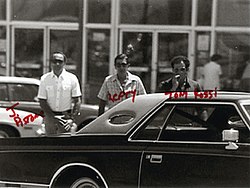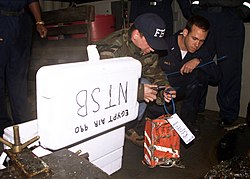Federal Bureau of Investigation
The Federal Bureau of Investigation (FBI) is an agency of the US government that investigates crime across the country. It is dedicated to national security and to law enforcement and often fights terrorism.[3]
| Federal Bureau of Investigation | |
| Abbreviation | FBI |
| Federal Bureau of Investigation's seal | |
| FBI special agent badge | |
| Flag of the Federal Bureau of Investigation | |
| Motto | Fidelity, Bravery, Integrity |
| Agency Overview | |
|---|---|
| Formed | 1908 (as the Bureau of Investigation), July 26 |
| Employees | 35,000[1] |
| Annual Budget | US$9,748,829,000 (FY 2021)[2] |
| Legal personality | Governmental agency |
| Jurisdictional Structure | |
| Federal agency | United States |
| General nature |
|
| Operational Structure | |
| Headquarters | J. Edgar Hoover Building Washington, D.C., U.S. |
| Agency executives | |
| Parent agency | Department of Justice Office of the Director of National Intelligence |
| Website | |
| fbi | |
The Bureau of Investigation was founded in 1908 and was renamed the Federal Bureau of Investigation (FBI) in 1935.[4][5] J. Edgar Hoover was the Director of the Bureau from 1924 to his death, in 1972.[6][7] Although the FBI works worldwide, its headquarters are in Washington DC. It has 56 main offices in cities throughout the United States.
Mission and priorities
The FBI's mission is to protect the US and maintain justice. They do this in many ways:
- They protect the United States from terrorist attacks.
- They protect the United States against foreign intelligence operations and espionage.
- They protect the United States against cyber-based attacks and high-technology crimes like hacking.
- They protect civil rights.
- They combat all national and international criminal organizations.
- They combat major white-collar crime and fraud.
- They combat important violent crime.
- They also support international partners.
Organization
Organizational structure
The FBI is organized into branches and the Office of the Director. This office contains most administrative offices. An executive assistant director manages each branch. Each branch is then divided into offices and divisions. Each division is headed by an assistant director. The various divisions are further divided into sub-branches. Each sub-branch is led by deputy assistant directors. Within these sub-branches there are various sections headed by section chiefs. Section chiefs are ranked analogous to special agents in charge.
Four of the branches report to the deputy director while two report to the associate director. The functions branches of the FBI are:
FBI Crisis Negotiation Unit
The FBI Crisis Negotiation Unit (FCNU) is a 24/7 operational response to crisis and to negotiate person(s) who are threatening to commit suicide or other harmful situations after a crime has been committed. The FBI's lead negotiator contacts the person(s) involved, with a hard-wire phone line to communicate with the person(s) to try convincing them to give themselves up to local police who are on stand-by.
Federal Bureau Of InvestigationFBI Crisis Negotiation Unit Media
J. Edgar Hoover, FBI director from 1924 to 1972
The "suicide letter", mailed anonymously to King by the FBI
An FBI surveillance photograph of Joseph D. Pistone (aka Donnie Brasco), Benjamin "Lefty" Ruggiero and Edgar Robb (aka Tony Rossi), 1980s
FBI SWAT agents in a training exercise
An FBI agent tags the cockpit voice recorder from EgyptAir Flight 990 on the deck of the USS Grapple (ARS 53) at the crash site on November 13, 1999.
Redacted policy guide for the Counterterrorism Division (part of the FBI National Security Branch)
References
- ↑ "About: How many people work for the FBI?". fbi.gov.
- ↑ "FY 2021 Authorization And Budget Request to Congress". United States Justice Department. February 2020. Retrieved January 9, 2021.
- ↑ Clare Kim (January 6, 2014). "FBI drops 'law enforcement' from its mission statement". MSNBC. NBC Universal. Archived from the original on January 8, 2014. Retrieved January 8, 2014.
- ↑ Weiner, Tim 2012. Enemies: a history of the FBI. Random House. ISBN 978-1-4000-6748-0.
- ↑ Unger, Sanford J. 1975 FBI: an uncensored look behind the walls. Boston: Little, Brown. ISBN 0-316-88744-7
- ↑ Gentry, Curt 1991. J. Edgar Hoover: the man and the secrets. Plume. ISBN 0-452-26904-0
- ↑ Summers, Anthony 2003. Official and confidential: the secret life of J. Edgar Hoover. New York: Putnam. ISBN 0-399-13800-5












